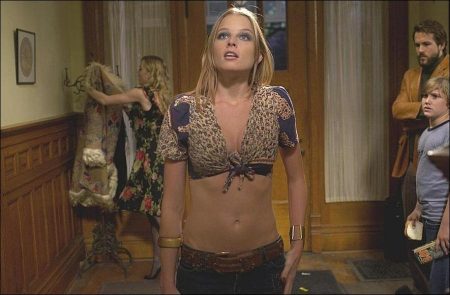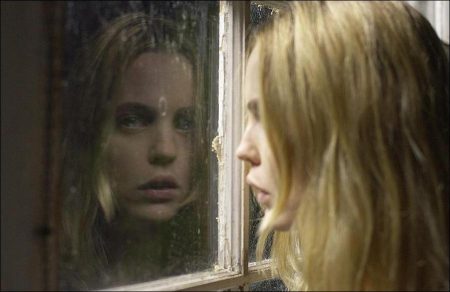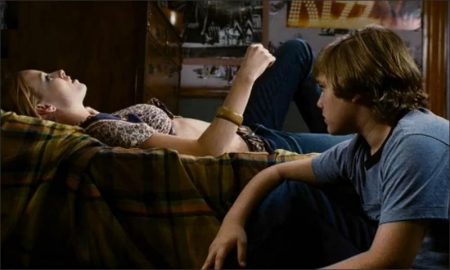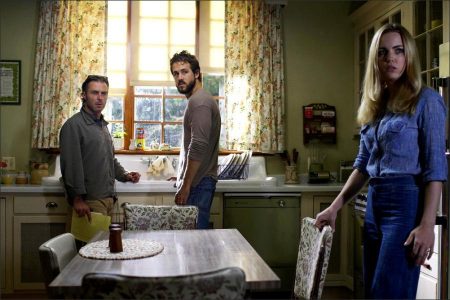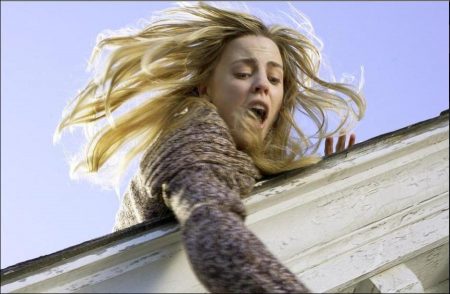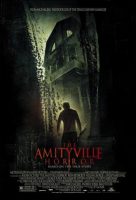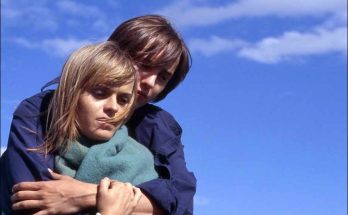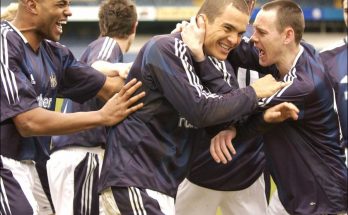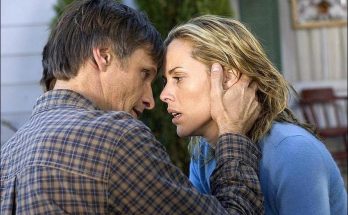About the Production
The original The Amityville Horror achieved staggering success on many levels after its wildly successful opening on July 16, 1979. Audiences were horrified by the story, based on the true-life account of the 28 days that George and Kathy Lutz lived at 112 Ocean Avenue in Long Island, New York, in 1974. Starring James Brolin and Margot Kidder, the film was a blockbuster hit, grossing $86.4 million domestically and establishing itself as a cult classic endeared and loved by legions of horror fans around the world.
The Amityville Horror’s original score was nominated for an Academy Award, and the film has entered into the iconography of popular culture by way of its main character, a menacing Dutch Colonial house whose evil pair of jack o’lantern “eyes” is forever etched in the minds of movie audiences. George Lutz’s account of what happened during his family’s brief encounter with the legendary residence is often considered one of the greatest haunted house stories of all time.
Hot off the success of 2003’s The Texas Chainsaw Massacre, Platinum Dunes producers Michael Bay, Andrew Form, and Brad Fuller signed a first-look deal with Dimension Films. In keeping with the company’s mantra of developing and producing modestly budgeted horror and thriller films, the trio began searching for their next project.
“After Texas Chainsaw Massacre, we looked at what audiences responded to in the marketing of that film,” says producer Form. “What we found was that people were most frightened by the fact that it was inspired by a true story.”
“Horror is a very visceral emotional response,” adds Fuller. “Its power is magnified when audiences believe what they’re seeing onscreen could actually happen to them. Horror films based in reality strike a much deeper chord and tend to linger in the minds of movie audiences long after they have left the theater.” That dynamic became the inspiration for the filmmakers to remake The Amityville Horror.
“The new material we’d been receiving didn’t strike a chord with us, so we began looking at older films that were inspired by real events or people,” says Form. “I grew up on Long Island ten minutes away from Amityville and remember driving by the house in the middle of the night with my friends and being scared out of my mind.”
He continues, “The Amityville Horror book sold ten million copies. No one can dispute that Ronald DeFeo, Jr., woke up in the middle of the night and murdered his six family members, and it became an enormous debate on how a man could shoot eight rounds from a Marlin rifle, which can be heard miles away, and not have one person in the house or a neighbor wake up.”
With several unsuccessful sequels produced throughout the years, the filmmakers felt they needed to go back to Jay Anson’s book and keep the film based on the actual events that took place before and after George and Kathy Lutz moved in.
“The Amityville Horror book contained a lot of great material that never made it into the original film,” says Fuller. “We all felt that if we researched the case extensively and spoke with as many people connected to the actual events as possible, we could make a terrifying movie of what really happened to George and Kathy Lutz.”
As with The Texas Chainsaw Massacre, the filmmakers were extremely cognizant of the challenges and pitfalls of remaking a successful horror film, one that has been the subject for debate for many years.
“The biggest challenge in remaking a film is that audiences are going to immediately compare it to something else,” says Fuller. “There are a lot of strong opinions about The Amityville Horror and what did or did not happen. When we came up with the idea to make this film, we all agreed the best way to develop the story was to take the key parts of the original film and integrate them with elements from the book that were never explored.”
The Amityville Horror was green-lit by MGM, who would retain domestic distribution, with Dimension Films picking up foreign distribution. With the film’s distribution set, the filmmakers focused on finding a writer who could mix the best elements from the original with some fresh new storylines inspired by and detailed in Jay Anson’s book.
The filmmakers didn’t have to look far to hire screenwriter Scott Kosar – he had previously written The Texas Chainsaw Massacre. “We wanted the film to have more of a psychological angle, and the most important thing was having characters audiences could connect with and care about,” says Form. “Scott did a great job for us on our last film, and one of the things we love about him is how in depth he goes in researching a project. We knew he would dig as deep as humanly possible to make sure the story we were telling was compelling and truthful.
“Michael, Brad and Andrew always put me through a hellish development process, yet their process brings out the best in me,” laughs Kosar. “With Amityville, I liked the challenge of retelling a classic haunted house story in a way that would frighten a contemporary audience. The trouble with the haunted house genre is that the conventions are so recycled. In the ‘90s they relied heavily on CGI as a means of telling old stories with a new aesthetic. This version of The Amityville Horror relies less on special effects and more on psychological horror.”
“When I first saw the film, I was a young kid with a not-so-healthy interest in horror films – particularly films involving demonic possession,” says Kosar. The most chilling aspect of this story is the horrible tragedy that befell the DeFeos. “Home invasion is a theme that always pushes peoples’ buttons, but when the invasion comes from within the family, it’s especially horrific,” Kosar continues. “The storyline I focused on was the connection between Ronnie DeFeo and George Lutz – how the spirits were leading George down the same road that Ronnie followed to his doom.”
With Kosar hammering out the first draft of the script, the filmmakers’ search for a director led them to highly touted and successful commercial director Andrew Douglas, who makes his motion picture debut on the project.
“When Michael Bay established Platinum Dunes, he wanted to give commercial directors their first opportunity to direct a motion picture,” says Form. “That’s where Michael got his start, and the talent pool we typically look at are directors who’ve done many commercials or videos and are looking to cross over into films. Marcus Nispel did a terrific job for us on our previous film, and when we came up with the concept for this film, Andrew Douglas was a guy who had been on our radar for a long time.”
“Andrew also has a visual style that complemented this story,” adds Fuller. “This is a psychological horror film about a family disintegrating because of its attempt to realize the American dream. That’s horrifying in a whole different, deeper level. We all felt Andrew was a director who could tap into that truthfulness and make the film both frightening and emotionally compelling at the same time.”
One of the top commercial directors in the world with a distinctive style that manages to be both timeless and contemporary, Douglas has directed hundreds of commercials for such clients as Nike, Coca-Cola, Chrysler, Volvo, United Airlines, Merrill Lynch, Minolta, Audi, Ford, Lexus, Hewlett Packard, Microsoft, and Verizon. “In Hollywood, diligent producers are always looking out for who is rising to the top in their respective visual mediums,” says Douglas. “As a wannabe feature filmmaker, you’re kind of in the same position and have your eye open for interesting projects. They tend to be action films and horror films because it’s conventional wisdom that the genre will play to a commercial director’s strength: a modern visual style.”
With Douglas on board, the filmmakers began the daunting task of scouting cities to find a house that resembled the iconic Amityville mansion. “We searched all over the United States looking for the perfect house located on a body of water, but we kept coming up short,” says Form. “We had location scouts looking all over the country, and after months of searching we finally found a piece of land on a beautiful body of water outside of Chicago. We were creating the blueprints for the house when a tremendous amount of rain fell, flooding the lake and destroying that piece of land.”
“For about twelve hours we were at a complete loss about what to do,” says Fuller. “Then our construction coordinator showed up at the production office and said, ‘There’s a house just over the border in Wisconsin that might work if you can add on to it.’ In a pinch, we all jumped in a car and headed out there. The minute we walked onto the property, we knew we had found our house.”
Although the filmmakers had found a house to serve as the foundation for the film, they were still left with the challenge of transforming the interior of the decaying 120 year-old structure and adding the trademark “eye” windows to the exterior in just six weeks. That responsibility rested on the shoulders of production designer Jennifer Williams.
“The house in Wisconsin was an extraordinary find,” says Williams. “It wasn’t easy to convince the owners to allow us to use the property, but once all the filmmakers saw the house and felt its presence, everyone agreed that if we were going to make this film it had to be done at that location.”
Williams continues, “The house is an old Victorian that was built in the late 1800s. Because of its extremely large scale and the roof lines, we were able to add the pumpkin face onto the south face of the structure. The house was also on a beautiful lake, and we had to build a boathouse with a long, steep set of stairs leading to it.”
“The first time I saw the house I was a little unsure whether we could make it work,” says Fuller. “But after Jennifer and her team attached the ‘face,’ it was shocking how much it looked like the original house. The 2005 version is larger, but it maintains the integrity of the Ocean Avenue residence while providing a dramatic setting for the story to unfold.”
Another challenge for Williams was the filmmaker’s decision to keep the film in the period of the 1970s. “When the owners finally let us inside the house, it was like walking through some kind of time warp,” she says. “It was full of old furniture, stair carpet, and wallpaper from the 1930s. We had to do a lot of work to the interior, including building a working kitchen, redoing all the bedrooms, and restoring all of the hardwood floors that had been neglected for decades.
“One great thing about the interior of the house,” she continues, “was that it was enormous and had a lot of stairs and winding staircases. With the film being a period piece, a house like this typically only had two telephones attached to the wall. It’s easy to see how difficult it would be to communicate with the outside world when something goes wrong inside the house.”
While Williams and her production design team were busy with construction, the filmmakers were immersed in the critical task of casting the character driven screenplay. The focal point of the story is George Lutz, a loving husband and father who becomes possessed by the evil forces lurking in his new home.
“Although George is a very likeable character in the beginning of the film, he slowly becomes obsessed with the house,” says Form. “It starts to have physical effect on him. The closer he gets to the basement, the more extreme his physical symptoms become and the more severe his personality changes. It’s a pretty complex character – in some ways the house becomes a material manifestation of George, and in other ways George is representative of everything evil that is going on in the house.”
In order for the film to work, the filmmakers needed a young actor who could seamlessly create the multi-dimensional character whose arc in the film ranges from loving father to mentally deranged killer.
“One of the first things we discovered before casting the film was how young the real characters were when these events took place in 1975,” says Fuller. “George Lutz was only 28 and Kathy Lutz was 30. They played it much older in the original movie, but we wanted to cast the roles true to their actual age.
“We also wanted to get actors who haven’t been seen in these kinds of roles before,” Fuller continues. “When Ryan Reynolds came in and met with us, it felt like a really fresh idea because he is so well known for his comedy. Ryan embodied everything we wanted George Lutz to be: charming and wonderful, but with the acting chops to spin it and get very harsh and evil.”
Reynolds, who rose to fame after his title role in the hit comedy Van Wilder, was initially hesitant when he first heard of the project. “I had some trepidation about the project when I heard the word ‘remake,’ because those types of films tend to be a bit gratuitous,” he says. “That feeling quickly dissipated after I read the script, which more closely followed the book. I found it intriguing they wanted to hire me. George Lutz was a pretty intense guy, and the film is basically about a man’s struggle to maintain his sanity while being drawn into this vortex of evil. Most of my work has been in the comedy genre, so it’s a dream role to get a chance to play a character that has a trajectory from A to Z.”
“What’s interesting about the character is that it poses the question: does the madness walk into the house, or does the house cause the madness?” says director Douglas. “We tried to make George Lutz as subtly flawed as we could, because we wanted to make a film that would work on both a supernatural and psychological level.
“For the film to work it was vital for the George Lutz character to be very likable at the beginning of the film,” continues Douglas. “You have to love the character in the beginning to hate him in the end. Ryan brought a charm and likeability to the character that wasn’t necessarily written on the page. Getting an audience to love him, hate him and then bring him back again is not easy for an actor to do, but Ryan pulled it off in spades.”
Shortly after moving into the new home, Kathy Lutz begins to sense subtle changes in her husband’s behavior and demeanor. As George grows more distant with each passing day, Kathy struggles to keep her family together. In casting the role, the filmmakers tuned to versatile actress Melissa George, who was coming off a memorable season as Jennifer Garner’s nemesis on the hit television show Alias.
“When we cast Ryan in the lead, we had to figure out who was going to play Kathy, and that presented us with some problems initially,” says Fuller. “Kathy is a very complex character; in the beginning of the film she seems very docile and domestic, but in the end she has to be an action hero protecting her kids from being killed. That’s a lot of ground to cover in 90 minutes, and we needed an actress who was very sexy but believable as protective mother of three children.”
“Kathy is a loving, beautiful, self-assured woman,” says George. “I think the reason they lasted for 28 days is because she was in denial the whole time about her husband going crazy and her family falling apart.”
“Melissa George also had a tall order in the film because when she takes over as the protagonist, she has to do it in a way which doesn’t compromise her character’s humanity,” says director Douglas. “If she suddenly becomes a one-dimensional action hero, the film loses something. She took all the conflicts, insecurities, and denials of her character and infused them into her performance in a way that was plausible and emotionally compelling.”
When asked whether she believes the Amityville events could really have happened, George says, “At the beginning I wasn’t sure. Seeing the original film, I was like ‘Whatever.’ And then I started to research and read what these people went through. They must have seen something. They must have gone through something because they never came back to the house to pick up one thing. Not a thing. They left and never came back. It must’ve been so bad. Something went on in that house.”
Reynolds and George were both pleased to find that the script shed light on the obvious question: Why would a family move into a house in the first place after they were told upfront about its horrific past?
“When the film opens you see this family living in a tiny apartment, and suddenly they have the opportunity to move to this incredibly large home on a lake with a boathouse, backyard, and bad history,” says Reynolds. “George Lutz is a contractor and knows he could never afford this kind of house under normal circumstances. He’s also feeling the pressure to provide for his new family. So he turns to Kathy and says ‘Houses don’t kill people. People kill people.’”
When casting was completed, the filmmakers were truly pleased with the actors they assembled. “All the actors bring even more to the screen than what’s written on the page,” says Fuller. “Ryan and Melissa responded to the material in a manner that allowed them to get inside the heads of these characters and flesh out the little nuances and ticks that really make a performance special and memorable. We were also very lucky to find four very young actors who were fearless and mature enough to handle the very dark material in the script.”
“All of the cast was so consistent day after day, it took so much of the pressure off directing my first film,” says Douglas. “The young kids were phenomenal. We never had to wait on them and they stayed really focused, which allowed us to maximize the short periods of time we were permitted to use them.”
As the filmmakers began final preparations for the 51-day shooting schedule to take place in suburban Chicago and Wisconsin, they decided to fly several cast members in early so they could bond as a family unit.
“We wanted Melissa to really get to know the kids before we started shooting,” says Form. “We felt it was vital for audiences to get know these characters in the first act and feel how much they all cared for each other. If you can achieve that level of character development, it raises the stakes in the second and third acts.”
“I spent a lot of time getting to know the kids and took them all to Six Flags,” says Melissa George. “I spent all day running around after them, making sure they were tall enough for the rides and basically pretending they were my own children.”
While George and her onscreen children spent time together, Reynolds chose the opposite approach in the days leading up to the start of principal photography. “I didn’t want to spend any time getting to know the kids before we started shooting, because if I started to like them it would make my job even harder,” says Reynolds, referring to the fact that George Lutz becomes more threatening to the children as his madness escalates. “There’s that old adage ‘This is going to hurt me more than it hurts you,’ and I’m here to tell you it’s true. Doing scenes with kids in which you’re being emotionally abusive is really difficult.”
On August 2, 2005, production began at the 120 year-old Victorian house, newly transformed into the home of George and Kathy Lutz. For both Reynolds and George, seeing their new set up close for the first time was impressive.
“The house is the predominant character in the movie,” says Reynolds. “It’s funny because at the beginning of the film, we’re almost ancillary characters to the house, and throughout the story George slowly becomes one with the house. When I first saw the house there was something about it that was off. Those ‘eyes’ make you feel like they’re always watching you.”
“It’s a creepy house, and no one has lived in it for a really long time,” adds Melissa George. “When I first got here, the producers said, ‘Do you want to go and see the house?’ I said, ‘What scene are we shooting on our first day?’ They said ‘The scene where Kathy and George first see the house.’ I told them no because I didn’t want to see the house until we rolled cameras on the first take, which would ensure a completely organic reaction to the house.”
Another similar moment for George was shooting the scene where George and Kathy Lutz come home to find their youngest child standing on the 42-foot-high rooftop peak of the house. “Chelsea goes up on the roof to play with her imaginary friend, Jodie,” says Melissa George. “George and Kathy are horrified to see her precariously balancing on the edge of the roof peak, one misstep away from falling to her death.”
The scene required child actress Chloe Moretz to walk the length of the house on a six-inch beam standing 42 feet above the ground. The filmmakers turned to world renowned action coordinator Kenny Bates.
“When we conceived this film, there were some seminal action sequences that we absolutely had to shoot,” says Fuller. “Kenny has worked with Michael Bay many times and is the best action coordinator in the business. There were a lot of people who thought we were crazy to put a young actress up there, but Kenny was the guy who could get her up there without it being an issue.”
For Moretz, the sequence was all in a days work. “I was nervous at first,” she says, “but once I got up there and felt the harness and wires were going to keep me safe, I felt okay. The only time I got scared was when my foot slipped off the edge and I flew out over the house. For a second I forgot I had my harness on and thought I was going to fall. When we finally finished, I didn’t want to come down because it was so much fun up there flying around.”
“Kenny was very diligent about building trust with Chloe and having her understand how the wires would protect her,” says Form. “It was amazing to see her evolution from the first day on the roof when her steps were very tentative to the third day when she was jumping around and walking without any fear. Those shots worked because of Kenny’s ability to build her trust and make everyone around him feel very safe.”
Even actress George, who spent two seasons performing her own stunts on the action series Alias, was impressed with Moretz’s roof work. “Chloe is a really strong kid and did an amazing job,” she says. “There was a part of the scene where I was hanging over the edge of the roof with Chloe grasping onto my arm while she was dangling 40 feet above the ground. When they yelled action, she looked up at me with her eyes rolled back in her head and it was just such a horrifying image. I only let her do a few takes though, because it was so unpleasant to see.”
Throughout the course of the 51-day shooting schedule, the filmmakers were consistently blown away by the level of commitment and physical stamina shown by Ryan Reynolds and Melissa George. “It was an incredibly rigorous shoot, and it seemed like we were beating up Ryan and Melissa both physically and mentally every day,” says Fuller. “They were rained on for days at a time with cold lake water, covered in mud, and hit with guns and axes. But somehow they always managed to be in good spirits and did whatever we asked of them, time and time again.”
For their part, George and Reynolds were equally impressed with their director’s ability to manage the complexities of their characters. “What I loved about Andrew Douglas was his sensitivity with each shot,” says George. “He made the house feel like a character that was constantly watching us, and he really brought a psychological element to the film. He didn’t just rely on jumpy shots and close-ups of us freaking out.”
“Andrew Douglas had a great take on each character,” adds Reynolds. “He felt each scene was a microcosm of what the entire picture is, and he was always willing to work out every beat for as long as you needed.”
Regardless of their views on the supernatural, the cast and crew had a hard time dismissing the many strange occurrences that happened at the production’s Amityville House recreation on Silver Lake in remote Salem, Wisconsin.
“When you have a house as old as this one, you’re always going to hear ghost stories about it,” says Reynolds. “You take them with a grain of salt. But several times during filming, a bunch of the lights went on and off in the house during the middle of the night. The security guards couldn’t ever find anybody in the house or explain how it could happen. I also woke up at 3:15 a.m. the first night of shooting, which was really freaky.”
“Everyone was always falling down inside the house for no apparent reason and things would mysteriously disappear,” says Melissa George. “It was also crazy that the house was located in town of Salem, which is also the name of the town the DeFeos were from. The thing that freaked me out the most, though, was Kathy Lutz passing away during the second week of filming. She was only 59 years old and I just thought it was such a strange coincidence.”
As principal photography wrapped in Buffalo Grove, Illinois on October 21, 2004, cast and crew alike felt they had all shared in a truly unique film experience. “The reason this is one of the most famous haunted house stories is because it is based in reality,” says producer Form. “It’s a fact that Ronald DeFeo murdered his entire family for no apparent reason while they were peacefully sleeping in their beds. It’s a also a fact that George and Kathy Lutz and their three kids ran for their lives after 28 days and left all of their possessions behind. Hopefully this film will give audiences insight into what caused a perfectly normal family to be shaken to its core and act in such a manner.”
The Amityville Horror (2005)
Directed by: Andrew Douglas
Starring: Ryan Reynolds, Melissa George, Jimmy Bennett, Jesse James, Rachel Nichols, Jimmy Bennett, Chloë Grace Moretz, Philip Baker Hall, Isabel Conner, Annabel Armour
Screenplay by: Scott Kosar
Production Design by: Jennifer Williams
Cinematography by: Peter Lyons Collister
Film Editing by: Roger Barton, Christian Wagner
Costume Design by: David C. Robinson
Set Decoration by: Daniel B. Clancy
Art Direction by: Marco Rubeo
MPAA Rating: R for violence and terror, sexuality, language and brief drug use.
Distributed by: Metro Goldwyn Mayer
Release Date: April 15, 2005
Views: 351
